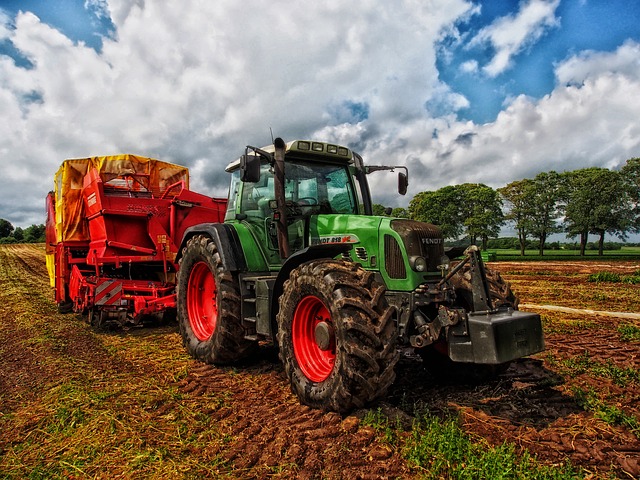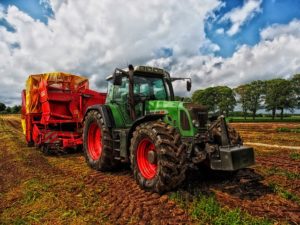
Thousands of years ago, farming revolutionized human societies. It allowed us to settle in one place and to have surplus food, freeing some people to pursue other specialized labor. Populations grew, cities flourished. Today, it is impossible to think about life without agriculture. But did you know that some animals have been farming for much longer than us?
Insects are probably the most well known farming animals, but accomplished farmers have been documented among fish, crustaceans, and mollusks as well. Even microorganisms have been reported to farm. In 2011 a group of researchers reported on the amoeba Dictyostelium discoidelium, which farms bacteria.
Some animals practice very advanced forms of agriculture, which include preparing the growth medium, propagating their crop, tending their gardens, fertilizing and harvesting the crop, and transmitting it from parents to offspring. The most advanced forms of animal farming belong without a doubt to the insects, but many other animals practice simpler farming techniques too.
Meet some of these amazing animals below, and stay tuned to Part 2 of this series for a look into the more advanced farming species.
1. Yeti Crabs
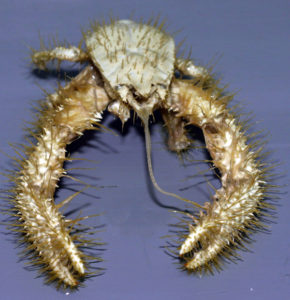
In 2005, researchers discovered a new species of crab, Kiwa hirsuta, at a hydrothermal vent in the South Pacific Ocean. It was a bizarre creature, covered in hair-like structures called setae, which earned it the common name of Yeti crab. However, only one specimen was collected, and many questions remained about the crabs’ diet and feeding strategy.
Then, in 2006 a second Yeti crab species was discovered off the coast of Costa Rica, on a methane seep. These crabs, Kiwa puravida, displayed an odd habit of rhythmically waving their claws over areas of methane seepage (see video below).
Examination of different specimens revealed that the hairy structures on the crabs’ claws were covered by chemosynthetic epibiotic bacteria. By studying the composition of the crabs’ tissues, researchers were able to determine that these bacteria constitute the Yeti crabs’ main food source. The crabs fertilized their bacterial crops by swaying their claws over the methane seepage sites, allowing nutrients to wash over the bacteria. They then use a specialized mouth appendage to transfer the bacteria from the setae to their mouths.
Video S1: Kiwa puravida at Mound 12, Costa Rica demonstrating the rhythmic waiving of its chelipeds (Thurber et al., 2011).
In 2015, a third species of Yeti crab was discovered living on hydrothermal vents in the Antarctic Ocean, Kiwa tyleri. Dense setae covering its ventral side give it the appearance of a hairy chest, for which it has been nicknamed the “Hoff crab“, after the actor David Hasselhoff.
Source:
Thurber, A.R., et al. 2011. Dancing for Food in the Deep Sea: Bacterial Farming by a New Species of Yeti Crab. PLoS ONE, 6(11): e26243.
2. Damselfishes
Damselfishes are a group of small to medium fish living mostly in saltwater ecosystems, and many of which inhabit the world’s tropical coral reef systems. They have a reputation for being feisty and territorial. Damselfishes feed on small crustaceans and other small organisms, sponges, and algae. Some algae- eating damselfish species are actually accomplished gardeners, tending carefully to their algae garden, from which they feed.
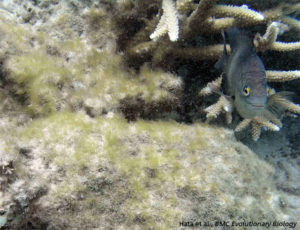
The damselfish Stegastes nigricans, a little fish with an unassuming appearance, is one such dedicated farmer. It inhabits tropical coral reefs between 30°S and 30°N of the equator, and assiduously keep patches of the filamentous red algae Polysiphonia sp. It keeps watch over his algae patch aggressively, weeding out other algae species, and defending the patch against other herbivores. Researchers observed that when damselfishes were removed, other species of algae readily invaded the Polysiphonia patches.
Although this behavior is beneficial for both damselfish and algae, there might be some negative effects for the health of the coral reef. In its effort to create space for its algae garden, the aggressive weeding by the damselfish prevents coral polyps from attaching. Also, the algae in their garden can harbor bacteria associated with coral disease. In a 2014 research paper, Casey et al. reported greater bacterial concentration and incidence of black band disease within S. nigricans territories than outside.
Sources:
Hata, H. and Kato, M. 2006. A novel obligate cultivation mutualism between damselfish and Polysiphonia algae. Biology Letters, 2: 593-596.
Casey, J.M., et al. 2014. Farming behaviour of reef fishes increases the prevalence of coral disease associated microbes and black band disease. Proceedings of the Royal Society B, 281(1788): 20141032.
3. Marsh Snails
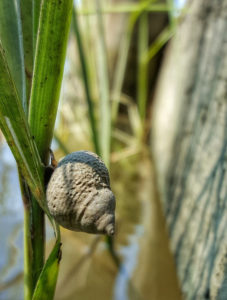
Littoraria irrorata, also known as the Marsh periwinkle, is a species of salt-water snail that lives in salt marshes on the Atlantic and Gulf coasts of North America. This surprising little farmer grazes on stalks of cordgrass, but not to eat. Rasping with its radula, it creates longitudinal grooves on the stalks. Opening up the plant’s tissues facilitates invasion by ascomycete fungi, which are abundant in the salt marsh environment, and are the periwinkle’s preferred food.
These snails have even been observed fertilizing their fungus crops with their feces, which are rich in nutrients and fungus hyphae.
Source:
Silliman, B.R. and Newell, Y. 2003. Fungal farming in a snail. Proceedings of the National Academy of Sciences, 100(26): 15643-15648.
These are just a few examples of animals that have developed farming relationships with their food, a type of symbiosis referred to as cultivation mutualism. In the next post, we’ll learn about some of the more advanced animal farming societies.
